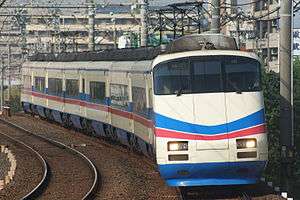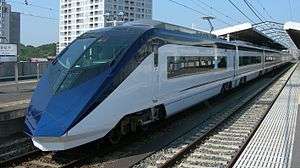Keisei AE100 series
| Keisei AE100 series | |
|---|---|
|
A Keisei AE100 series on a Skyliner service in October 2008 | |
| In service | June 1990 – February 2016 |
| Manufacturer | Nippon Sharyo |
| Replaced | Keisei AE series |
| Constructed | 1990–1993 |
| Refurbishment | 2001–2003 |
| Scrapped | 2010–2016 |
| Number built | 56 vehicles (7 sets) |
| Number in service | None |
| Formation | 8 cars per trainset |
| Operator(s) | Keisei Electric Railway |
| Line(s) served | Keisei Main Line |
| Specifications | |
| Car body construction | Steel |
| Doors | 1 per side |
| Maximum speed | 110 km/h (70 mph) |
| Electric system(s) | 1,500 V DC |
| Current collection method | Overhead wire |
| Track gauge | 1,435 mm (4 ft 8 1⁄2 in) |
The Keisei AE100 series (京成AE100形) is a DC electric multiple unit (EMU) train type operated between 1990 and 2016 by the private railway operator Keisei Electric Railway on Cityliner limited express services between Tokyo and Keisei Narita in Japan. First entering service in June 1990, the trains replaced the earlier AE series EMUs operating on Skyliner services providing a link between Tokyo and Narita Airport. They had a slant-nosed design with hidden headlamps.[1]
Formations
As of 1 April 2015, two 8-car sets (131 and 161) remained in service out of the original fleet of seven sets.[2]
The sets were formed as shown below, with six motored (M) cars and two unpowered trailer (T) cars, and car 1 at the Narita end.[2]
| Car No. | 1 | 2 | 3 | 4 | 5 | 6 | 7 | 8 |
|---|---|---|---|---|---|---|---|---|
| Designation | M2C | M1 | T | M2 | M1' | T | M1 | M2C |
| Numbering | 1x1 | 1x2 | 1x3 | 1x4 | 1x5 | 1x6 | 1x7 | 1x8 |
- Cars 2 and 7 were each fitted with two scissors-type pantographs.[3]
- The "x" in the individual car numbering corresponded to the set number (1 to 7).
- Cars 1 and 8 were originally designated as smoking cars, but all cars became no-smoking from 17 July 2010.[4]
Interior
Passenger accommodation consisted of standard class seating only, configured 2+2 abreast with pairs of reclining seats that could be rotated to face the direction of travel.[3] Car 4 was equipped with a toilet and also a wheelchair space.[4] Car 5 had a drink vending machine.[4]
 Interior view, July 2007
Interior view, July 2007- Seats
History
The first trains were introduced from June 1990, replacing the earlier AE series sets.[5]
The fleet underwent refurbishment between 2001 and 2003,[5] with modifications internally to improve wheelchair accessibility, and changes to the moquette seat covers.[3] From 17 July 2010, all AE100 series trains were transferred to Cityliner services.[4]
Following the reduction in the number of Cityliner services, five of the original seven sets were withdrawn and scrapped between 2010 and 2012, leaving just two sets in operation.[5]
From the start of the revised timetable on 5 December 2015, regular Cityliner services were discontinued, leaving the two remaining AE100 series sets without regular duties, although seasonal services were scheduled to continue until the end of January 2016.[6] Two special farewell runs were organized by Keisei Travel on 21 and 28 February 2016, following which the AE100 series trains were officially withdrawn.[7]
References
| Wikimedia Commons has media related to Keisei AE100 series. |
- ↑ Keisei AE100 Series
- 1 2 私鉄車両編成表 2015 [Private Railway Rolling Stock Formations - 2015] (in Japanese). Japan: Kotsu Shimbunsha. 23 July 2015. p. 27. ISBN 978-4-330-58415-7.
- 1 2 3 私鉄車両年鑑2012 [Japan Private Railways Annual 2012] (in Japanese). Tokyo, Japan: Ikaros Publications Ltd. February 2012. p. 135. ISBN 978-4-86320-549-9.
- 1 2 3 4 私鉄車両編成表 2013 [Private Railway Rolling Stock Formations - 2013] (in Japanese). Saitama, Japan: Kotsu Shimbunsha. 30 July 2013. p. 35. ISBN 978-4-330-39313-1.
- 1 2 3 大手私鉄 栄光の特急車両はいま・・・ [Where is famous major private railway limited express rolling stock now...]. Japan Railfan Magazine (in Japanese). Vol. 54 no. 634. Japan: Koyusha Co., Ltd. February 2014. p. 106.
- ↑ Meguro, Yoshihiro (February 2016). 京成AE100形 [Keisei AE100 series]. Japan Railfan Magazine (in Japanese). Vol. 56 no. 658. Japan: Koyusha Co., Ltd. pp. 72–73.
- ↑ 『さよならAE100形 記念ツアー 』2回目が開催される [Second "Farewell AE100 series" commemorative tour held]. Japan Railfan Magazine Online (in Japanese). Japan: Koyusha Co., Ltd. 1 March 2016. Retrieved 16 March 2016.

